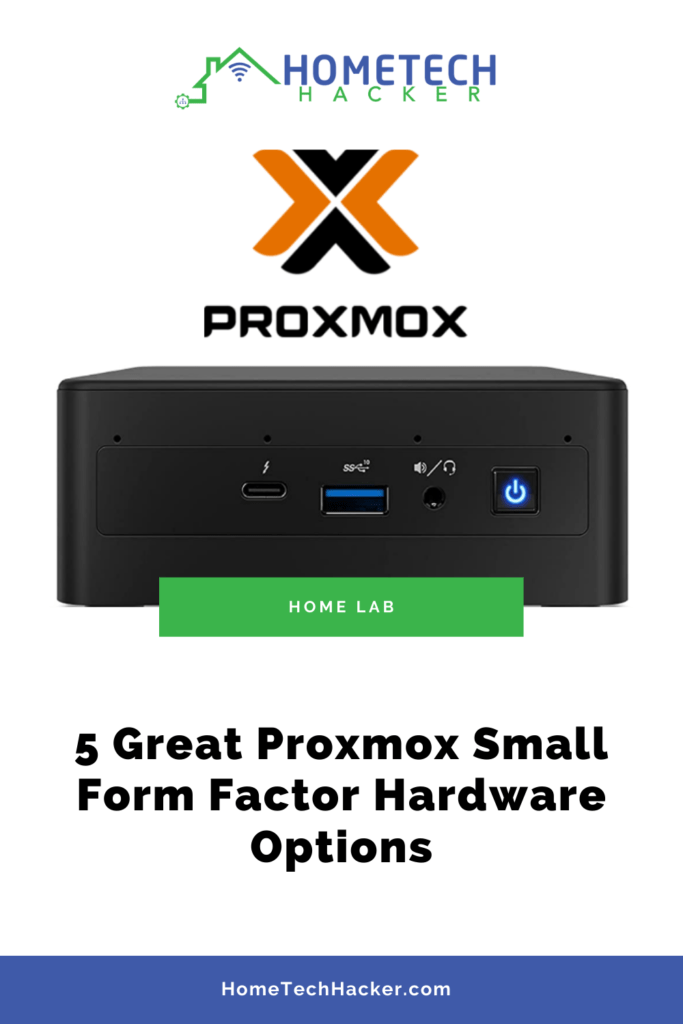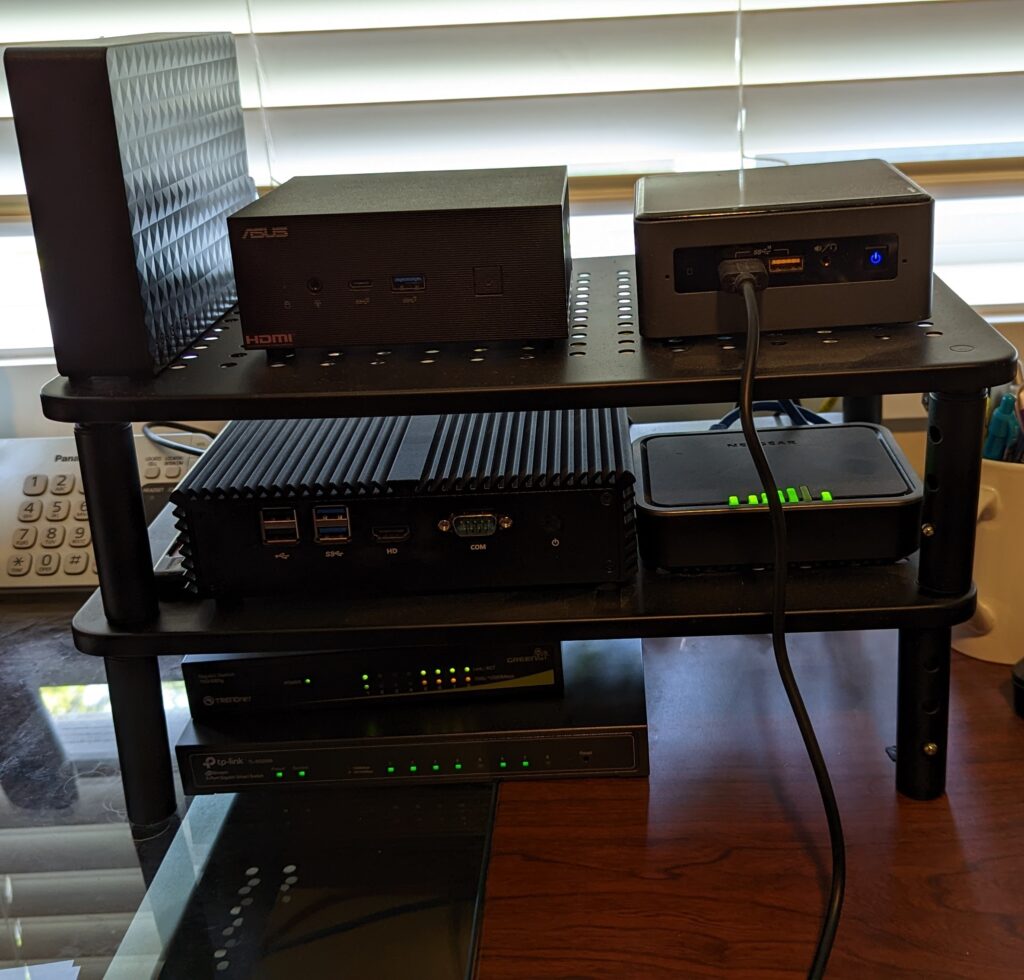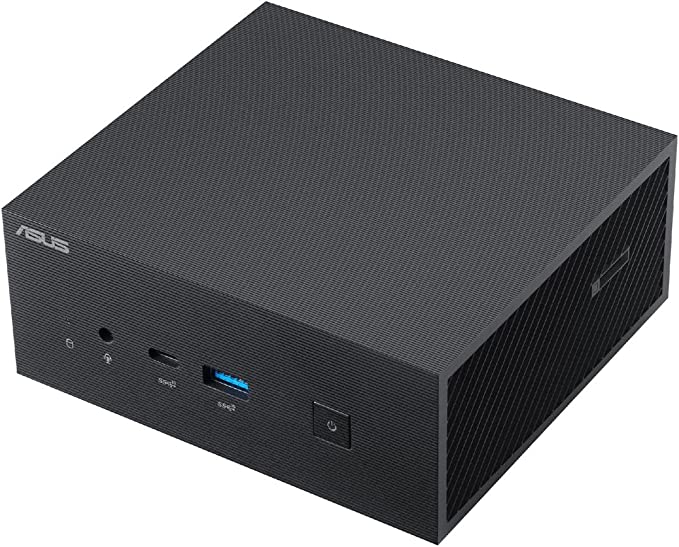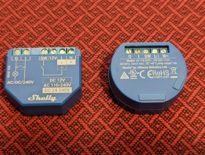
Looking for small form factor hardware options for your latest Proxmox build? So am I! I’m going to share the options I’m considering that might just be what you are looking for too!
Editor’s note: This article was last updated on 10/01/2023. If you are looking for small form factor hardware with faster connections check out my article about Proxmox capable hardware with 2.5GbE NICs.
Table of Contents
What is Proxmox VE?
Proxmox VE, which I generally refer to as just Proxmox in this article, is an open-source virtualization management solution. It integrates the KVM hypervisor and LXC container solutions and provides a web-based front end for managing them.
It can run as a single node or in a cluster. Proxmox supports various storage models, automatic scaling, failover, snapshots, backups, and other popular virtualization features.
I use Proxmox to power my home lab. I run virtual machines that run Home Assistant, file servers, Docker containers like MQTT, Graylog, the Omada access point controller (for my TP-Link access points), and more.
It is built on the Debian Linux distro. Proxmox VE is free for consumer use. You can learn more about it here.
This page contains affiliate links. If you purchase an item using an affiliate link I will receive a small commission at no cost to you. Affiliates do not influence my recommendations. Read my disclosures for more information.
Proxmox hardware requirements
The minimum hardware requirements for Proxmox are easy to achieve:
- CPU: 64bit (Intel EMT64 or AMD64)
- Intel VT/AMD-V capable CPU/Mainboard (for KVM Full Virtualization support)
- Minimum 1 GB RAM
- Hard drive
- One NIC
The real requirements are really based on your needs. How many VMs do you plan to run? How power-hungry are the VMs? Do you plan to use external storage? You’ll need the answer to these questions before deciding on your own personal requirements.
Criteria for good small form factor Proxmox hardware
First, let me say that these options are geared toward home lab users, not business users. I’m primarily using my own criteria for these selections which are:
- Very small footprint — I’d like this server to fit on my server “rack” next to my current Proxmox-powered NUC server. You can see a picture of my rack below :). This article is titled small form factor, but really I prefer ultra-small form factor.
- Consumer-grade hardware — I’m not against server-grade hardware like ECC RAM, but for my needs and budget, I tend to lean towards consumer hardware that is easier to source.
- At least four cores — I like to run multiple VMs and containers, and I’d like to have the cores my VMs will want.
- More build, less buy — I’ve built my fair share of computers, but I’d rather not search for each and every component for this. I prefer a prebuilt solution, but a bare-bones package where I’m adding RAM and disk would be fine too.
- Quiet — The less fan noise the better. I do most of my work from the room that houses my servers.

Option #1: Intel NUCs
- Strong Performance: Intel nuc12 mini pc with newest 12th generation Intel Core i5-1240P Processors (12MB Cache, up to 4.40 GHz) 12 Cores, 16 Threads, built-in 35W Intel Iris Xe Graphics, up to 1.3 GHz, 80 EU units
- Built-In: Intel nuc i5 Barebone built-in 35W Intel Iris Xe Graphics, Wi-Fi 6E AX211, Bluetooth 5.3, 2x Thunderbolt 4, Ethernet LAN (RJ-45), No RAM, No SSD, NO OS
Intel NUCs are the standards of compact computing. They are used for everything from virtualization servers, to routers, to desktop computers. They can pack a lot of power in a small quiet box, and, for their size, are fairly customizable.
One of my current primary Proxmox servers is a NUC 8 (NUC8i5BEH). It comes with an 8th Gen Intel Core i5-8259U processor. I outfitted it with 32GB of Crucial RAM (2×16 GB sticks), a Western Digital Blue 500 GB NVME SSD (Proxmox OS drive plus images), and a Samsung 860 Evo 500 GB SSD (for VMs).
This small but powerful machine runs 4 VMs and 20 docker containers without breaking a sweat.
If you are looking for something with a more modern processor (and a higher price tag) you could also check out this NUC 13 (NUC13ANHi7) which comes with a smoking Gen 13 Core i7 processor. You’ll need to give a hard drive and some RAM. Beyond NUCs, keep reading this article to see the latest Proxmox host I bought. Here are some NUCs worth considering:
Option #2: Beelink mini PCs
- 【High-Performance Processor】Beelink MINI S built-in faster 11 generation Intel Jasper Lake Processor N5095 base frequency 2.0GHz, up to 2.9 GHz. (4C/4T, 4M Cache) It runs much faster than i3-5005u, N3450, j3455, j4125, j4105 etc. chips. Loaded With 8gb DDR4 Ram, 256gb SSD, creates a very smooth experience for your visually home entertainment, streaming video, Web browsing, work, and games.
- 【Storage Expansion Options】The MINI S Mini Computer built-in 8 GB DDR4, 256GB M.2 SSD (M.2 is much better than mSATA/HDD in terms of both smaller size and higher transfer performance) and supports up to 2TB of 2.5-inch SATA HDD / SSD.
Beelink mini PCs offer a similar form factor and performance to the mid-level NUCs, but usually at a cost savings for what you get. One downside is that they usually use Realtek network interface cards (NICs) instead of Intel. Realtek will work fine with Proxmox, but Intel NICs have long been the gold standard. The Beelink SE10 Mini PC comes with everything you need (11th gen Intel processor, 8 GB of RAM, 256 GB SSD) to get started running a robust Proxmox server.
Here are some Beelink Mini PCs you should consider:
Option #3: Refurbished small form factor desktops
- Work smarter not harder and streamline more with this PC’s enhanced powerful Intel Core i5 2.70 GHz processor.
- This PC allows you to store and quickly access up to 256GB SSD of storage with 16GB of Ram.
If you are okay with refurbished computers and slightly older hardware you can get some great deals on refurbished Lenovo ThinkCentre, HP Elitedesks, HP Prodesk, and Dell Optiplex small form factor PCs. They are bigger than NUCs and the Beelink, but still small compared to a regular desktop.
If you are on a budget, the Lenovo ThinkCentre M700, Dell Optiplex 3050 SFF, or HP EliteDesk 800 G3 will give you all you need to start with and are upgradable. The HP Prodesk 600 G2 will get you even more performance for a little bit more money.
Here are a few of these refurbished/renewed machines at different price points:
Option #4: Protectli and Qotom mini PCs
- Main Port: 1 HD Video + 1 COM + 2 USB 2.0 + 2 USB 3.0 + 6 LAN.
- CPU: Intel Core i5-7200U Processor (Kaby Lake, Dual Core, 3M Cache, 2.50GHz, up to 3.10GHz).
Sometimes you want a small form factor virtualization host with multiple NICs. If that’s you, take a look at the Protectli and Qotom machines. I’ve recommended many of these machines for pfSense hardware, and in fact, I use a Qotom for my own pfSense router.
These machines are whisper quiet, but they do have a little less power than the other recommendations in this article. If you need a beast, these might not be the machines for you, but I think they’ll work great for most home labs.
This Qotom comes with a whopping six gigabit NICs. This Protectli machine comes with six gigabit NICs and has as much power (some have more power) as many of the NUCs I’ve listed. Here are some additional Qotom and Protectli options:
Option #5: Other mini PCs
Many mini PC brands are out there that can get the job done. I recently bought an ASUS PN63-S1 (my review here) barebones to replace my more than decade-old loud and aging tower Proxmox host and it has been great. Here are a few more options to explore:

Final thoughts
Virtualization is a great tool to maximize the computing power in your home lab while minimizing hardware maintenance. You can also maximize your space by using a small form factor computer for virtualization. These small computers pack plenty of power for most home lab needs.
Did you find a good option for your Proxmox or other virtualization software needs? Is there one you’d recommend that I don’t have here? Let me know in the comments or on Twitter.































